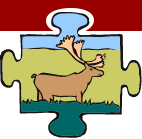LAND MAMMALS
Indicators
- Population size and trend
- Number harvested
- Habitat quality
- Reproductive rates
- Presence of diseases and parasites
- Age structure
- Distribution
- Food availability
- Presence of contaminants
|
Current Knowledge
Species included in this section are: wood bison, wolf, muskox, wolverine, Dall's sheep, fox, mountain goat, lynx, grizzly bear, beaver, black bear, mink, polar bear, and small mammals (snowshoe hare, arctic hare, porcupine, weasels, squirrels, lemmings, mice and voles).
There are 63 species of terrestrial (land) mammals in the NWT. Many are important to residents for food or as a source of income. We know a little about some species, and quite a bit about others. Most terrestrial mammal populations are in good condition; the exceptions are: wood bison, considered a threatened species; the grizzly bear considered sensitive in the NWT; polar bear is considered vulnerable; and mountain goats are considered at risk and at the northern limit of their range.
Contaminant levels are generally low in terrestrial mammals and are not considered a concern for animal or human food consumption.
Current Monitoring
- NWT species status rank infobase - Government of the Northwest Territories (GNWT)
- West Kitikmeot Slave Study - WKSS Society
- Traditional Ecological Knowledge Research Kache Kue Study Region - Lutsel K'e Dene First Nation
- NWT wildlife disease and parasite monitoring - GNWT
- NWT commercial wildlife harvest monitoring - GNWT
- Monitoring of non-resident and non-resident alien harvest from the Mackenzie Mountains - GNWT
- NWT fur harvest monitoring - GNWT
- NWT resident sport harvest monitoring - GNWT
- Gwich'in Settlement Area harvest study - Gwich'in Renewable Resources Board (RRB)
- Sahtu Settlement Area harvest study - Sahtu RRB
- Inuvialuit Settlement Region harvest study - Inuvialuit Joint Secretariat
- Harvest data collection in Paulatuk, Holman, Sachs Harbour -Fisheries and Oceans Canada (DFO), GNWT, and Canadian Wildlife Service (CWS)
- Harvest Data Collection in Aklavik - Yukon Territorial Government (YTG)
- Wildlife Effects Monitoring Program - BHP Diamonds Inc.
- Wildlife Monitoring Program - Diavik Diamond Mines Inc.
- Wildlife/habitat monitoring at Snap Lake - DeBeers
- Enbridge pipeline wildlife observation - GNWT
- Arctic Borderlands Ecological Knowledge - Cooperative
- Recovery of wood bison - GNWT
- Muskox mainland population surveys - ISR / Sahtu - GNWT
- Muskox island population surveys - GNWT
- Muskox population surveys - Parks Canada/YTG
- Monitoring of impacts from diamond mines in the Slave Geological Province - GNWT
- Grizzly bear harvest and occurrence databases - GNWT
- Monitoring of black bear diseases and parasites in the Dehcho - GNWT
- Polar bear harvest database - GNWT
- Monitoring and research studies on population boundaries and abundance through tagging programs - CWS and GNWT
- Lynx population monitoring of harvest levels and pelt length measurements from pelts turned in for auction - GNWT
- Wolf dens and pup counts on the central barrens - GNWT
- Wolf harvest monitoring the on Banks Island (Sachs Harbour) and NW Victoria Island (Holman) - GNWT
- Diet and morphometric measurements of Arctic wolves 1993-2002 - GNWT
- Wolverine populations are monitored using harvest statistics - GNWT
- NWT-wide wolverine carcass collection to improve monitoring of harvest patterns and health, age and sex composition - GNWT
- Dall's sheep - population size monitoring for Mackenzie Mountains, North Richardson Mountains, Canyon Creek sub-population, Mount Cronin sub-population - Southern Richardson Mountains - GNWT
- Parasite and disease studies of Dall's sheep in the Mackenzie Mountains - GNWT
- Dall's sheep population size monitoring in the Richardson Mountains - GNWT
- Monitoring growth rate pattern of harvested Dall's sheep rams in the Dehcho - GNWT
- Monitoring hunter reported observations of sex ratios of mountain goats in Mackenzie Mountains - GNWT
- Collecting DNA samples from goats harvested in the Dehcho - GNWT
- Beaver population monitoring - Sahtu - GNWT
- Marten carcass collection in select areas (for sex, age, population composition) - GNWT
- Monitoring abundance of small mammals - GNWT
- Studies of environmental effects of disturbances in the subarctic (SEEDS) - Small mammals - University of Alberta
- Snowshoe hare monitoring - GNWT
Gaps and Recommendations
Given the range of species under consideration, decisions on monitoring gaps still requires further review amongst biologists, co-management boards, and government agencies. Although few specific monitoring priorities have been established, several broad issues and recommendations are provided below:
- Improve baseline information on wildlife distribution and abundance, and understanding of natural variability in populations.
- Insufficient attention to cumulative effects relative to oil and gas exploration, pipeline construction, mining activity and anticipated increase in level of development activity in the north.
- Require better habitat and land-use mapping and understanding of how wildlife utilize available habitat.
- Requirement for standardized, broad multi-species survey techniques, collaborative monitoring efforts and data sharing.
- Absence of information to discriminate between effects of environmental variation and human activities.
- There is uncertainty about the potential impact of global warming on northern wildlife species.
This summary is based on: A Preliminary State of Knowledge of Valued Components for the NWT Cumulative Impact Monitoring Program (NWT CIMP) and Audit. February 1, 2002; updated February 2005.
For more details, you may also want to look at:
Top of page


